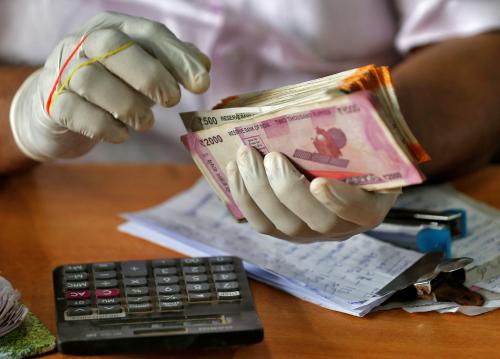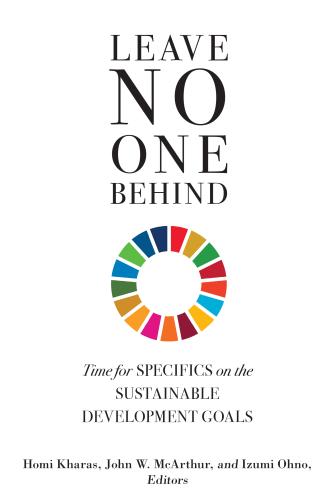In ancient times, debt jubilees were customary after wars or dramatic events. By wiping out debts, these jubilees sought to avoid polarization and social tensions. Today, the massive dislocations caused by the COVID-19 pandemic provide justification for the international community to countenance such a debt jubilee—especially for poorer countries, such as many of those in Africa.
Except for a few flashpoints, Africa has mainly been spared the type of massive sickness and death from the pandemic experienced by millions of people in Asia, Europe, and North and South America. Yet, Africa stands to incur the most serious economic and social consequences of the pandemic.
Both the International Monetary Fund (IMF) and the African Development Bank (AfDB) forecast a sharp decline in aggregate growth because of the global health crisis. Africa is set to experience its first recession in about two decades. When you take apart these aggregate forecasts and examine individual sectors, it becomes obvious why Africa stands to lose the most. Economies of the continent are heavily dependent on external flows that emanate from countries hit hard by the pandemic. Those flows include trade in oil and other commodities, foreign direct investment, remittances, development aid, and tourism. The tourism sector has been devastated and countries that depend on it are expected to experience growth declines in the double digits.
To avoid a lost decade similar to the one Latin America experienced from its 1980s debt crisis, the international community must help African countries avoid disorderly debt default and reignite growth.
The new low-growth normal that seems to be settling in is propelling debt distress to the forefront of the continent’s policy agenda. The recent default of Zambia has cast a shadow over the capacity of several other African countries to handle their debt. A back-of-the-envelope calculation that assumes a halving of growth prospects for the next 10 years and zero fiscal deficit throughout the period results in a 150 percent increase in the debt-to-GDP ratio. A widening fiscal deficit will lead to a further deterioration of that ratio.
Moreover, while the ratio of external debt-to-GDP is an important indicator of sustainability, low ratios can be an illusion of economic health. A favorable debt-to-GDP ratio can hide substantial “below-the-line financing.” Governments that have a relatively low ratio may in fact be forcibly borrowing from their economies. For example, a government engages in forced borrowing by not paying suppliers, which may reduce government borrowing needs, but will damage the productive system and delay economic recovery. Domestic arrears have become an increasing source of forced financing in sub-Saharan Africa. The IMF analysis also shows that domestic arrears have a negative impact on growth through multiple channels, including hurting the profitability of the private sector and stressing the banking sector. By undermining trust in government, arrears can even reduce fiscal policy effectiveness. The recent African experience also demonstrates that public liabilities may further increase when government guarantees are offered or where state-owned enterprises can accumulate debt without much control and transparency
Historically, debt resolution in Africa has been messy and protracted. Examples of such protraction of debt resolution are many. The Heavily Indebted Poor Countries Initiative took over a decade to be implemented. There are also ongoing litigations with external creditors concerning the Republic of the Congo and Angola.
The disorderly resolution of debt frequently leads to large and often permanent output losses. Worse, these disorderly episodes also led to socioeconomic instability. To avoid a lost decade similar to the one Latin America experienced from its 1980s debt crisis, the international community must help African countries avoid disorderly debt default and reignite growth.
How? The nature of sovereign debt contracts—which, contrary to corporate debt contracts, do not have established bankruptcy procedures—helps explain why debt restructurings tend to be disorderly. The absence of a clear set of rules to resolve sovereign insolvency creates room for opportunistic investors—such as vulture funds—to hold up the restructuring process and delay the resolution of debt distress. Tackling sovereign distress early on can reduce the duration of the crisis and associated output losses. Yet, authorities in debtor countries are often wary of acting early, fearing the potential effect on their reputation in international markets.
On November 22, the G-20 agreed to extend a freeze on official debt service payments until mid-2021 and exhorted private sector actors to participate on equal terms. But much more needs to be done to address the stock of debt. This will likely include deeper debt restructuring and debt cancellation, which, absent changes to the current framework, is likely to prove litigious and hard to achieve.
Ensuring an orderly resolution of debt requires important fixes to the international architecture. One such fix could be that government lenders that comprise the G-20 and the Paris Club adopt more stringent comparability of treatment clauses (CTCs) that force them to ensure that a debtor country’s agreements with other private and official creditors are similar to those reached with the G-20 and the Paris Club. The enforcement of such clauses would make it easier and speedier for official debt relief initiatives to translate into comparable relief from private creditors.
This mechanism could be particularly relevant for Africa, where the contribution of commercial creditors to Africa’s total external debt rose from 17 percent in 2000 to 40 percent by the end of 2019. China is the second top creditor to Africa since 2015, just behind bondholders. Bondholders alone accounted for 27 percent while China accounted for 13 percent of Africa’s debt at the end of 2019.
Countries cannot simply wait for debt relief from the official sector. They should firmly embark on a credible shift in their governance structures—including regional fiscal rules to constrain budgets and regional fiscal councils to advise governments on tax and spending policies—and help countries coordinate their fiscal policies. The benefits of regional commitments to enhance discipline and solidarity mechanisms are at least twofold. First, regionalization allows countries to rise above the intricacies of domestic politics. Second, regionalization offers the benefit of sharing risk.
In light of emptying government coffers, countries should consider aggressively eradicating leakages and curbing capital flight to create fiscal space and reignite growth. These policies will be aimed at ensuring government programs reach their targets (through more open governments and markets to reduce waste and monopoly rents) and enhancing mobilization of domestic resource revenue to finance green energy and digitalization infrastructures. Resource mobilization should not be restricted to tax revenue, in part because tax increases would be procyclical. Resource mobilization should also be about a better allocation of savings toward productive investments by shifting incentives of the banking system so it can fulfill their core functions of payment, price discovery, information production, and intermediation—through a combination of better macro policies and more competition in the financial system, including nonbank operators, which are making headway on payment systems on the continent.
Improved governance of public finances will not only help create fiscal space in the short run to allow governments to spend on public needs, but will also pave the way for more sustainable medium-term fiscal frameworks, which will help reignite growth. Strengthened competition policy frameworks—at the regional as well as country levels—will further help lift growth on the continent. Good governance and more vigorous and robust growth can set the stage for more profound changes in the way sovereigns obtain financing, potentially enabling African countries to use state-contingent debt instruments that link repayment schedules to capacity to pay using economic developments.
A more conducive international architecture of sovereign debt coupled with a shift in the governance system in Africa would not only help align debtors and creditors’ incentives to resolve debt problems. It may forestall any need to consider a debt jubilee down the road.








Commentary
How to reignite Africa’s growth and avoid the need for future debt jubilee
December 8, 2020